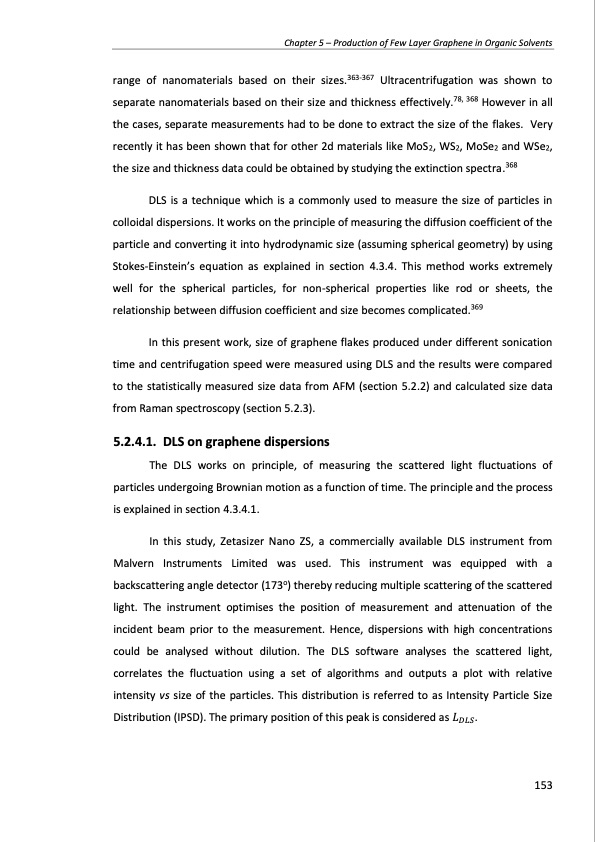
PDF Publication Title:
Text from PDF Page: 153
Chapter 5 – Production of Few Layer Graphene in Organic Solvents range of nanomaterials based on their sizes.363-367 Ultracentrifugation was shown to separate nanomaterials based on their size and thickness effectively.78, 368 However in all the cases, separate measurements had to be done to extract the size of the flakes. Very recently it has been shown that for other 2d materials like MoS2, WS2, MoSe2 and WSe2, the size and thickness data could be obtained by studying the extinction spectra.368 DLS is a technique which is a commonly used to measure the size of particles in colloidal dispersions. It works on the principle of measuring the diffusion coefficient of the particle and converting it into hydrodynamic size (assuming spherical geometry) by using Stokes-Einstein’s equation as explained in section 4.3.4. This method works extremely well for the spherical particles, for non-spherical properties like rod or sheets, the relationship between diffusion coefficient and size becomes complicated.369 In this present work, size of graphene flakes produced under different sonication time and centrifugation speed were measured using DLS and the results were compared to the statistically measured size data from AFM (section 5.2.2) and calculated size data from Raman spectroscopy (section 5.2.3). 5.2.4.1. DLS on graphene dispersions The DLS works on principle, of measuring the scattered light fluctuations of particles undergoing Brownian motion as a function of time. The principle and the process is explained in section 4.3.4.1. In this study, Zetasizer Nano ZS, a commercially available DLS instrument from Malvern Instruments Limited was used. This instrument was equipped with a backscattering angle detector (173o) thereby reducing multiple scattering of the scattered light. The instrument optimises the position of measurement and attenuation of the incident beam prior to the measurement. Hence, dispersions with high concentrations could be analysed without dilution. The DLS software analyses the scattered light, correlates the fluctuation using a set of algorithms and outputs a plot with relative intensity vs size of the particles. This distribution is referred to as Intensity Particle Size Distribution (IPSD). The primary position of this peak is considered as 𝐿𝐷𝐿𝑆. 153PDF Image | PRODUCTION AND APPLICATIONS OF GRAPHENE AND ITS COMPOSITES

PDF Search Title:
PRODUCTION AND APPLICATIONS OF GRAPHENE AND ITS COMPOSITESOriginal File Name Searched:
graphene-production-applications.PDFDIY PDF Search: Google It | Yahoo | Bing
Salgenx Redox Flow Battery Technology: Power up your energy storage game with Salgenx Salt Water Battery. With its advanced technology, the flow battery provides reliable, scalable, and sustainable energy storage for utility-scale projects. Upgrade to a Salgenx flow battery today and take control of your energy future.
| CONTACT TEL: 608-238-6001 Email: greg@infinityturbine.com | RSS | AMP |